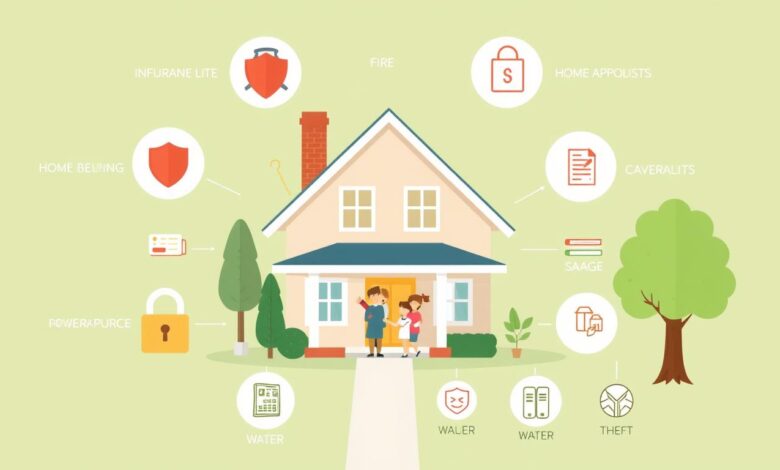Top 5 home Insurance Options to protect your home

Owning a home is a big deal, and keeping it safe is key. Home insurance is a must-have to protect your investment. It gives you peace of mind and financial security against unexpected events.
Whether you’re buying your first home or own several, knowing your insurance options is important. It helps you make smart choices and keep your home and belongings safe.
Key Takeaways
- Home insurance is essential to safeguard your property and assets against a range of risks, from natural disasters to theft and liability claims.
- Homeowners policies cover the structure of your home, your personal belongings, and provide liability protection in case someone is injured on your property.
- Specialized policies, such as flood or earthquake insurance, may be necessary depending on your location and potential risks.
- Evaluating the right coverage levels for your dwelling, personal belongings, and additional living expenses is crucial to ensure you are adequately protected.
- Liability protection is a key component of a homeowners policy, shielding you from financial responsibility in the event of accidents or injuries on your property.
Understand the Importance of Home Insurance
Home insurance is a key protection for homeowners. It shields them from financial loss due to unexpected events like natural disasters, theft, or liability claims. Without it, homeowners risk huge costs and could lose their home, their biggest asset.
Why Homeowners Can’t Afford to Skip Coverage
Without insurance, homeowners must pay for repairs or replacements themselves if disaster strikes. Natural disasters like hurricanes, tornadoes, and wildfires can cause massive damage. Theft or liability claims also pose big financial risks.
Common Risks and Scenarios Covered
- Damage to the home’s structure, including the roof, walls, and foundation
- Destruction or damage to personal belongings, such as furniture, electronics, and clothing
- Liability coverage for accidents or injuries that occur on the property
- Additional living expenses if the home becomes uninhabitable during repairs
A good homeowners policy protects against these risks. It helps homeowners recover and rebuild after unexpected events. Knowing the value of home insurance helps homeowners protect their most valuable asset.
| Coverage | Description | Deductibles |
|---|---|---|
| Dwelling Coverage | Covers the physical structure of the home and any attached structures | Typically range from $500 to $2,000 |
| Personal Belongings | Protects the homeowner’s personal possessions, such as furniture, clothing, and electronics | Usually around $250 to $1,000 |
| Liability Protection | Covers legal and medical expenses if someone is injured on the property | Vary based on the policy limits |
“Homeowners insurance is not just a luxury – it’s a necessity. Protecting your home and your financial well-being should be a top priority.”
Exploring Different Types of Homeowners Policies
Homeowners insurance protects your biggest investment – your home. But, not all policies are the same. It’s key to look at the various homeowners policies to find the right one for you.
Standard Homeowners Policy
The standard policy is the most common. It covers your home, belongings, liability, and extra living costs if something bad happens. It protects against many dangers like fire, theft, and some natural disasters.
Specialized Policies for Unique Needs
Some homeowners need more than the standard policy. Specialized policies can protect high-value items like jewelry or art. They also cover natural disasters like floods or earthquakes, which the standard policy might not.
| Policy Type | Key Features | Ideal for |
|---|---|---|
| High-Value Homeowners Policy | Enhanced coverage for valuable possessions, such as jewelry, fine art, and antiques | Homeowners with expensive or rare personal belongings |
| Flood Insurance | Protection against damage caused by floods, which are not typically covered by standard homeowners policies | Homeowners located in high-risk flood areas or those seeking additional coverage |
| Earthquake Insurance | Coverage for damage caused by earthquakes, which are also excluded from standard homeowners policies | Homeowners in seismically active regions |
Knowing about the different homeowners policies helps you choose the best one. This way, you can make sure your home and personal belongings are well-protected.
Key Components of a Home Insurance Policy
Understanding a home insurance policy can be tough. But knowing its main parts is key to protecting your home and belongings.
A typical policy has four main areas: dwelling coverage, personal belongings, liability protection, and extra living expenses. Let’s dive into each:
- Dwelling Coverage: This part covers your home’s structure against damage from fire, storms, and vandalism. You need enough coverage to rebuild your home if needed.
- Personal Belongings: Your policy also protects your stuff, like furniture and clothes. It covers items inside and outside your home against theft, damage, or loss.
- Liability Protection: This part helps if someone gets hurt on your property or if you damage their stuff.
- Additional Living Expenses: If your home is too damaged to live in, your policy can help with temporary housing and living costs until it’s fixed.
Knowing these policy parts well helps you make smart choices. It ensures your home and belongings are safe from many risks.
| Coverage Type | Description | Importance |
|---|---|---|
| Dwelling Coverage | Protects the physical structure of your home | Ensures your home can be repaired or rebuilt in the event of damage |
| Personal Belongings | Covers your personal possessions, both inside and outside the home | Safeguards your valuable personal belongings from theft, damage, or destruction |
| Liability Protection | Shields you from financial responsibility if someone is injured on your property | Provides legal and financial protection in the event of a liability claim |
| Additional Living Expenses | Covers the extra costs of temporary housing and living expenses if your home becomes uninhabitable | Ensures you have the resources to maintain your lifestyle while your home is being repaired or rebuilt |
“Comprehensive home insurance coverage is not a luxury, but a necessity for protecting your most significant investment and your family’s well-being.”
Evaluating Dwelling Coverage and Personal Belongings
Home insurance has two key parts: dwelling coverage and personal belongings protection. Knowing about these can help protect your home and stuff from unexpected events.
Determining Adequate Dwelling Coverage
Dwelling coverage protects your home’s structure, like walls, roof, and foundation. It’s crucial to get the right coverage to fix or rebuild your home if it’s damaged. To figure out the right amount, think about the cost to rebuild your home. Consider its size, materials, and local building costs.
Protecting Your Personal Possessions
Your policy should also cover your personal items, like furniture, electronics, and clothes. Make a detailed list of your stuff and its value. This ensures you have enough personal belongings coverage. Update this list often as your items change or grow in value.
By checking your dwelling coverage and personal items protection, you can feel safe. Regularly look over and tweak your coverage to fit your needs.
Additional Living Expenses and Liability Protection
When a covered loss happens, your home insurance does more than fix the damage. It also helps with unexpected costs. This includes additional living expenses and liability protection.
What Are Additional Living Expenses?
Additional living expenses, or ALE, cover the extra costs when you can’t live in your home. This could be due to a fire or natural disaster. It includes costs for temporary housing, meals, and other needs while your home is being fixed or rebuilt.
ALE coverage starts when your home is no longer safe to live in. It helps keep your living standard the same until you can move back. The coverage amount varies, so knowing your policy’s limits is key.
The Importance of Liability Protection
Liability protection is also vital in home insurance. It covers you if someone gets hurt on your property or if you damage someone else’s. This protection can safeguard your assets if you face a lawsuit or claim.
Liability limits can be from $100,000 to $500,000 or more, based on your policy. Higher limits offer more liability protection and peace of mind, especially if you have a lot to protect.
Understanding the value of additional living expenses and liability protection helps ensure your home insurance covers you fully. This way, you can protect your home and finances in case of a covered loss.
Conclusion
In this article, we’ve looked at how important home insurance is. It protects your most valuable thing – your home. We’ve covered the risks homeowners face and the different types of policies out there.
Getting a strong home insurance policy is key. It keeps your home and things safe from unexpected events like natural disasters and theft. It also protects you from liability claims. This way, you can rest easy knowing your financial well-being is safe.
When you look at your homeowners policy or think about getting a new one, think about what you need. Look at the coverage options and talk to a trusted insurance provider. With the right home insurance, you can enjoy your home and make memories. You’ll be ready for whatever comes next.
FAQ
What is the purpose of home insurance?
Home insurance protects your property and belongings from unexpected events. This includes natural disasters, theft, and liability claims. It ensures you can repair or replace them if needed.
What are the common risks and scenarios covered by home insurance?
Home insurance covers many risks. This includes damage from fires, storms, and theft. It also covers vandalism and liability claims. If your home is not livable, it covers extra living costs.
What are the different types of homeowners policies?
There are two main types of policies. The standard policy covers your home, belongings, liability, and extra living costs. Specialized policies offer more for high-value items or specific risks.
What are the key components of a home insurance policy?
A policy has several key parts. Dwelling coverage protects your home. Personal belongings coverage guards your stuff. Liability coverage helps with lawsuits. Additional living expenses cover temporary housing costs.
How do I determine the appropriate level of dwelling coverage?
To find the right coverage, think about rebuilding your home. This cost is usually more than your home’s market value. Talk to your insurance provider to ensure you have enough to rebuild.
How can I protect my personal belongings?
Your policy covers your belongings from theft and damage. Make a detailed inventory of your stuff. Then, talk to your provider to set coverage limits based on your belongings’ value.
What are additional living expenses, and how are they covered by home insurance?
Additional living expenses (ALE) cover costs if your home is not livable. This includes temporary housing and meals. Your policy will help you keep your standard of living while your home is fixed.
How does liability protection work in a home insurance policy?
Liability protection helps if someone gets hurt on your property. It covers legal costs and settlements. This protects your assets from lawsuits or claims.




